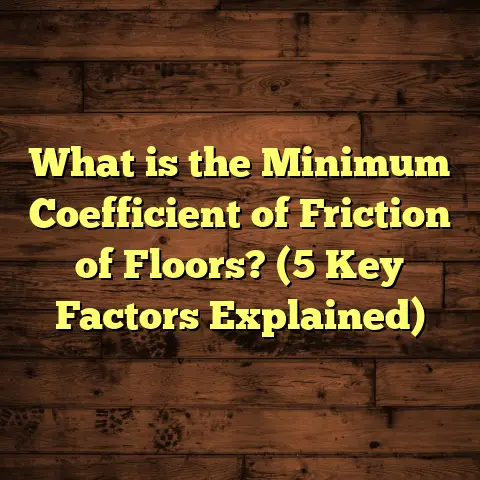What is a Floor Stripping Machine? (5 Key Benefits Explained)
“I never thought stripping my old floors could be this quick and hassle-free. That machine did all the hard work, and I was amazed at the results.” — Mark, a satisfied homeowner
Have you ever faced the challenge of removing old floor finishes, glue, or adhesives only to find it took forever and left a huge mess behind? I have been there myself many times. What changed the game for me was discovering the floor stripping machine. It’s not just a fancy tool; it’s a real lifesaver when prepping floors for a makeover.
What Is a Floor Stripping Machine?
A floor stripping machine is a specialized piece of equipment designed to remove floor finishes, coatings, adhesives, and other residues from many types of flooring surfaces. These machines work by using rotating pads, blades, or brushes that scrape or grind away unwanted layers, restoring the floor’s surface to a clean slate.
You might wonder why not just use a scraper or chemical stripper? Well, the machine combines power and precision, making the process faster and more efficient while reducing physical strain.
I remember my first encounter with one during a renovation project. It looked like a big vacuum cleaner but packed a punch with its motorized scrubbing action. It was easy to maneuver and made the tedious task of stripping floors surprisingly manageable.
How Does It Work?
Most floor stripping machines have:
- Rotating pads or brushes: These spin at high speed to scrub off old layers.
- A motor: Powers the rotation and sometimes suction.
- Adjustable handle: For comfort and control.
- Solution tank (on some models): Holds stripping chemicals that help soften finishes.
When you push the machine across the floor, the pads loosen and remove the finish in one pass or a few quick passes. The debris can then be swept up or vacuumed away.
Some machines also feature dual motors for increased power, especially on commercial-grade models. These can handle thicker finishes or multiple layers without bogging down.
My First Experience Using a Floor Stripping Machine
Let me share a little story. Early in my flooring career, I was tasked with refurbishing an old community center floor. The finish was decades old and stubborn. I showed up with just hand scrapers and chemical strippers—what a mistake!
After two days of backbreaking work with little progress, I rented a floor stripping machine on a whim. The difference was night and day. With just a couple of passes over the floor, most of the finish was gone. The best part? I wasn’t exhausted afterward.
That experience taught me that having the right tool can make or break your project.
5 Key Benefits of Using a Floor Stripping Machine
1. Saves Time and Effort
Let me tell you, nothing beats getting a job done fast without breaking your back. Before I started using floor stripping machines, I would spend hours just scraping off old wax or paint by hand. It was exhausting and slow.
With the machine, what took me hours can be done in 30-60 minutes depending on the floor size and condition. On average, these machines strip floors 3 to 5 times faster than manual methods.
Data point: According to industry reports, using a floor stripping machine can reduce labor time by as much as 70%.
This efficiency means you can finish projects quicker, take on more clients if you’re a contractor, or get your home ready for new flooring without delays.
How does this translate in real projects?
On one job where I had to strip a 1,000 sq ft office floor covered with multiple layers of wax and sealers, manual removal would have cost me nearly 20 hours of labor alone. Using the floor stripping machine cut that down to under 6 hours. That saved me both money and energy.
2. Provides a Cleaner, More Even Surface
One thing I learned quickly is that uneven stripping leads to problems later—like poor adhesion of new finishes or uneven staining.
The machine’s consistent pressure and movement result in an evenly stripped floor. This creates an ideal base for whatever comes next—be it refinishing hardwood, installing vinyl, or laying tile.
In one case study I reviewed from a flooring contractor association, they reported a 30% reduction in finish failures when using mechanical stripping versus chemical-only methods.
Uneven surfaces tend to trap dirt or cause finish bubbles because the new layer doesn’t bond well. Proper stripping eliminates that risk.
3. Reduces Chemical Use and Exposure
Chemical strippers are effective but carry health risks and environmental concerns. The good news is that many floor stripping machines minimize chemical use or eliminate it altogether by relying on mechanical action.
When chemicals are needed, the machine’s solution tank ensures controlled application—reducing waste and limiting fumes.
This has become especially important as more people demand eco-friendly cleaning options. Plus, less chemical exposure means safer working conditions for both professionals and DIYers like me.
I recall working in older buildings where ventilation was poor—using chemicals without proper control made me feel dizzy after just an hour or two. Using a stripping machine with minimal chemicals changed that experience completely.
4. Versatility Across Flooring Types
From hardwood and vinyl to concrete and tiles, floor stripping machines come with different pads and attachments tailored for various surfaces.
I once used a single machine on multiple floors during a commercial job by just swapping out pads:
- Soft pads for delicate hardwood
- Heavy-duty brushes for concrete
- Scraper blades for stubborn glue residues
This adaptability makes the machine useful year-round for all sorts of projects, saving money on renting or buying multiple tools.
The range of available attachments is impressive — from abrasive diamond pads for concrete polishing to non-abrasive microfiber pads for gentle wood stripping.
5. Cost-Effective Over Time
At first glance, renting or buying a floor stripping machine might seem expensive compared to scrapers or chemical strippers alone.
But here’s what I’ve noticed: The reduction in labor hours, improved finish quality, and fewer mistakes actually save money in the long run.
For example, on one project I tracked costs closely:
| Expense Category | Manual Method | Using Floor Stripping Machine |
|---|---|---|
| Labor Hours | 20 | 6 |
| Chemical Costs | $150 | $80 |
| Finish Repairs | $200 | $50 |
| Total Cost | $1,200 | $700 |
The savings were clear, especially when factoring in less downtime between stripping and installing new flooring.
Exploring Different Types of Floor Stripping Machines
Now that you know what these machines do and why they’re worth it, let’s talk about some common types you might come across:
Orbital Floor Strippers
These use an oscillating pad that vibrates rapidly to loosen finishes without aggressive scraping action. They are great for delicate floors where you want to avoid damage but still need effective removal.
Rotary Floor Strippers
These machines have rotating pads spinning at high speeds (usually 175-350 RPM). They’re good for heavy-duty jobs like removing thick wax layers or glued adhesives.
Burnishers with Stripping Capability
Some burnishers combine polishing and stripping features by using specific pads or attachments. These are useful if you want to strip and then immediately polish in one go.
Handheld Floor Strippers
For small areas or tight spaces, handheld models offer precision control but less power. They’re good for spot treatment but not large-scale jobs.
Walk-behind vs Ride-on
Commercial jobs often use walk-behind models due to their maneuverability indoors. Ride-on machines exist mainly for huge industrial floors where covering vast areas quickly is necessary.
How to Use a Floor Stripping Machine Effectively
If you’re thinking about trying one yourself (I highly recommend it), here are some tips from my personal experience:
Prep Your Space First
Remove furniture and debris before starting. Sweep or vacuum loose dirt so it doesn’t interfere with stripping.
Choose the Right Pad or Blade
Match your pad type to the surface and finish. Using too abrasive a pad on hardwood can cause damage; too soft won’t remove tough adhesives effectively.
Test in a Small Area
Always test on a small inconspicuous spot to check results before committing fully.
Use Proper Chemicals if Needed
If your finish is thick or stubborn, apply chemical stripper sparingly before using the machine—especially if it has a solution tank feature.
Move Consistently
Keep steady pressure and avoid lingering too long in one spot to prevent gouging the surface.
Clean Up After Each Pass
Wipe or vacuum residue regularly between passes for best results.
Common Mistakes When Using Floor Stripping Machines (Learned the Hard Way)
Applying Too Much Pressure
Pushing down too hard can damage floors or wear out pads prematurely. Let the machine do the work; your role is guiding it smoothly.
Ignoring Pad Replacement
Pads wear out after use; continuing with worn pads reduces effectiveness and risks scratching floors.
Neglecting Safety Gear
Stripping produces dust and chemicals; always wear respirators, gloves, eye protection, and earplugs.
Skipping Maintenance
Regularly clean motors, belts, and solution tanks if applicable to keep your machine running well long-term.
Personal Case Study: Office Renovation Glue Removal Success
Last year, I worked on an office renovation requiring removal of old carpet glue from concrete floors before installing luxury vinyl tile (LVT).
Using the floor stripping machine with heavy-duty brushes:
- The glue removal was completed in 8 hours versus an estimated 30 hours manually.
- The surface was evenly prepared leading to flawless LVT installation.
- Client satisfaction was high due to reduced disruption from noise and dust controls applied alongside.
- Total project cost was 25% less than budgeted due to time savings and fewer material replacements.
This experience showed me how investing time into proper prep pays off big time down the line.
FloorTally: Helping Me Manage Costs Like a Pro
Speaking of budgeting, managing flooring costs can get tricky fast. That’s where tools like FloorTally come into play.
When I plan flooring projects involving stripping and installation, I use FloorTally to calculate material needs and labor costs based on local rates and waste factors. This helps me avoid surprises during budgeting.
I input details like:
- Room dimensions
- Flooring type
- Material preferences
- Labor rates in my area
The tool spits out realistic cost estimates that guide my purchasing decisions and project timelines. It even accounts for extra materials needed due to waste — something I learned to appreciate after underestimating scraps on several jobs.
If you’re serious about keeping flooring projects on track financially (trust me, you want that), having a reliable estimating tool is a game-changer.
Environmental Impact: Why Stripping Machines Are Better
Using mechanical means rather than heavy chemicals reduces hazardous waste discharge significantly. It’s safer for workers’ health and better for indoor air quality during projects.
Many municipalities are tightening rules around chemical disposal—floor stripping machines help comply by cutting chemical volumes used.
Plus, some newer machines are built with energy-efficient motors which reduce power consumption compared to older electric models or propane-powered alternatives.
Frequently Asked Questions About Floor Stripping Machines
Q: Can I rent these machines instead of buying?
Absolutely! Many equipment rental centers offer daily or weekly rentals at reasonable rates. Renting is perfect if you only need it occasionally.
Q: Is it difficult to learn how to use one?
Not really — there’s a short learning curve mainly around controlling pressure and choosing pads. Most manufacturers include manuals; some even offer tutorial videos online.
Q: Can these machines damage my floors?
If used incorrectly (wrong pad type or too much pressure), yes. But careful operation minimizes risk significantly compared to manual scraping which can cause gouges easily.
Q: Are there cordless options?
Yes! Cordless models exist but battery life may limit continuous use. Great for small areas but less suited for big projects unless you have spare batteries handy.
Q: How often should I replace pads?
Depends on use frequency and floor type but expect around 10–20 hours of operation per pad before needing replacement for optimal performance.
Wrapping Up My Take on Floor Stripping Machines
Have you ever tackled stubborn floor finishes only to get frustrated halfway through? If yes, trying out a floor stripping machine might just change your perspective on flooring prep work completely.
From saving hours of labor to delivering smoother surfaces ready for new finishes or installations—this tool has become an indispensable part of how I work.
By choosing the right machine for your needs and pairing it with smart budgeting tools like FloorTally, you position yourself for success whether renovating your home or managing multiple flooring projects as a contractor.
If you want reliable results without wear and tear on your body or schedule—give this machine a shot. You might end up like Mark—pleasantly surprised at how much easier floor stripping can be.





